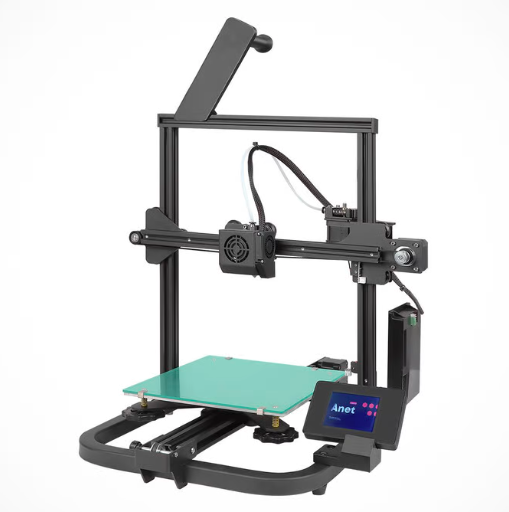Compare CR 10 Smart Pro vs A8 V2
Comparison between the best 3D printers
Choose the best 3D printer at the best price. The cheapest 3D printers are here.
Buy a 3D printer here with 3D Fila.
 |
 |
|
| Model | CR 10 Smart Pro[BUY CR 10 Smart Pro] |
A8 V2 |
| Printing Material | Filament | Filament |
| Buy Filament for Creality 3D CR 10 Smart Pro | Buy Filament forAnet A8 V2 | |
| Estimated price | $900,00 | $129,00 |
| Manufacturer | Creality 3D | Anet |
| Release Year | 2020 | 2021 |
| Print Volume [mm] | 300x300x400 | 220x220x250 |
| Printer Size [mm] | 578x522x648 | 428x441x486 |
| Weight [kg] | 13,6 | 6,2 |
| Power Loss Recovery | YES | NO |
| Enclosed printer | NO | NO |
| Bed Leveling | Manual | Manual |
| Filament End Sensor | YES | NO |
| Bed type | Heated | |
| Power supply system | Bowden | Bowden |
| Standard nozzle | 0,4 | 0,4 |
| Maximum Nozzle Temperature [°C] | 300 | 230 |
| Maximum Bed Temperature [°C] | 100 | |
| Maximum printing speed [mm/s] | 50 | 150 |
| Filament holder | YES | YES |
| Camera for supervision | YES | YES |
| Recommended filaments | PLA, PETG, Tritan, Flex, ABS | PLA |
| Recommended slicers | Cura, Simplify, Slic3r, IdeaMaker | Cura, Simplify, Slic3r, IdeaMaker |
| Maximum Resolution [mm] | 0,1 | 0,1 |
| Processor | ||
| Display | Display touchscreen 4,3'' | Display touchscreen 2,8'' |
| Power Supply | 110/220V / 350W | 110/220V / 250W |
| Connectivity | SD / USB / Wi-Fi / Ethernet | SD / USB |
| Operating systems | Windows, Mac, Linux | Windows, Mac, Linux |
| Date of registration in the system | 2022-11-04 | 2022-11-10 |
| Release date | 2020 | 2021 |
| Extra features | Creality's CR-10 Smart Pro printer offers a large 300x300x400mm build volume, Sprite Pro direct extruder for multiple materials, CR Touch auto-leveling, PEI magnetic bed, 4.3" touchscreen, LED lighting, and Creality Cloud connectivity. Some areas of improvement include the use of brass spindle nuts and tinned wires. | The Anet A8 V2 is a Cartesian-XZ type 3D printer with a build volume of 220 x 220 x 250 mm, Ender 3 design and V-slot assembly. It has a 32-bit motherboard and touchscreen interface, promising ease of use. It uses open source firmware and has thermal failure protection. It stands out for its cable organization and the absence of a heated bed, focusing on energy savings and PLA printing. It comes with an external power adapter, aiming at greater safety, especially for beginners and educational use. |
| Support for multiple colors and materials (AMS and CFS) | NO | NO |
Notes * |
||
| Cost-benefit | 6 / 10 | 6 / 10 |
| Hardware | 2.5 / 10 | 0.5 / 10 |
| Tela | . | . |
| Print volume | 4 / 10 | 3 / 10 |
| Performance | 1 / 10 | 1 / 10 |
| [BUY CR 10 Smart Pro] |
Conclusion |
| In comparing the CR 10 Smart Pro and the A8 V2, several factors highlight their respective strengths and weaknesses, especially when considering price, features, and overall performance. The CR 10 Smart Pro, priced higher than the A8 V2, offers a significantly larger print volume and superior capabilities, such as power loss recovery, an assisted bed leveling system, and a filament end sensor. These features enhance usability, especially for more demanding projects. Additionally, it supports a wider range of materials and has a robust set of extra features, including a larger touchscreen interface and enhanced connectivity options. The maximum temperatures for both the nozzle and the bed are also notably higher, allowing for more versatile printing. On the other hand, the A8 V2 is a cost-effective option, particularly appealing to beginners or those focused on simple PLA printing. Its lower price point makes it accessible, while its 32-bit motherboard and open-source firmware provide opportunities for customization and learning about 3D printing fundamentals. However, it lacks features such as automatic bed leveling, power loss recovery, and advanced material compatibility, which limits its functionality compared to the CR 10 Smart Pro. Overall, if you are seeking a reliable printer for a variety of materials and larger projects, the CR 10 Smart Pro justifies its higher cost with advanced features and enhanced performance. Conversely, for those on a budget or just entering the world of 3D printing, the A8 V2 remains a practical choice, offering solid entry-level capabilities. Ultimately, the decision hinges on budget constraints, intended use, and the user’s level of experience in 3D printing. |

